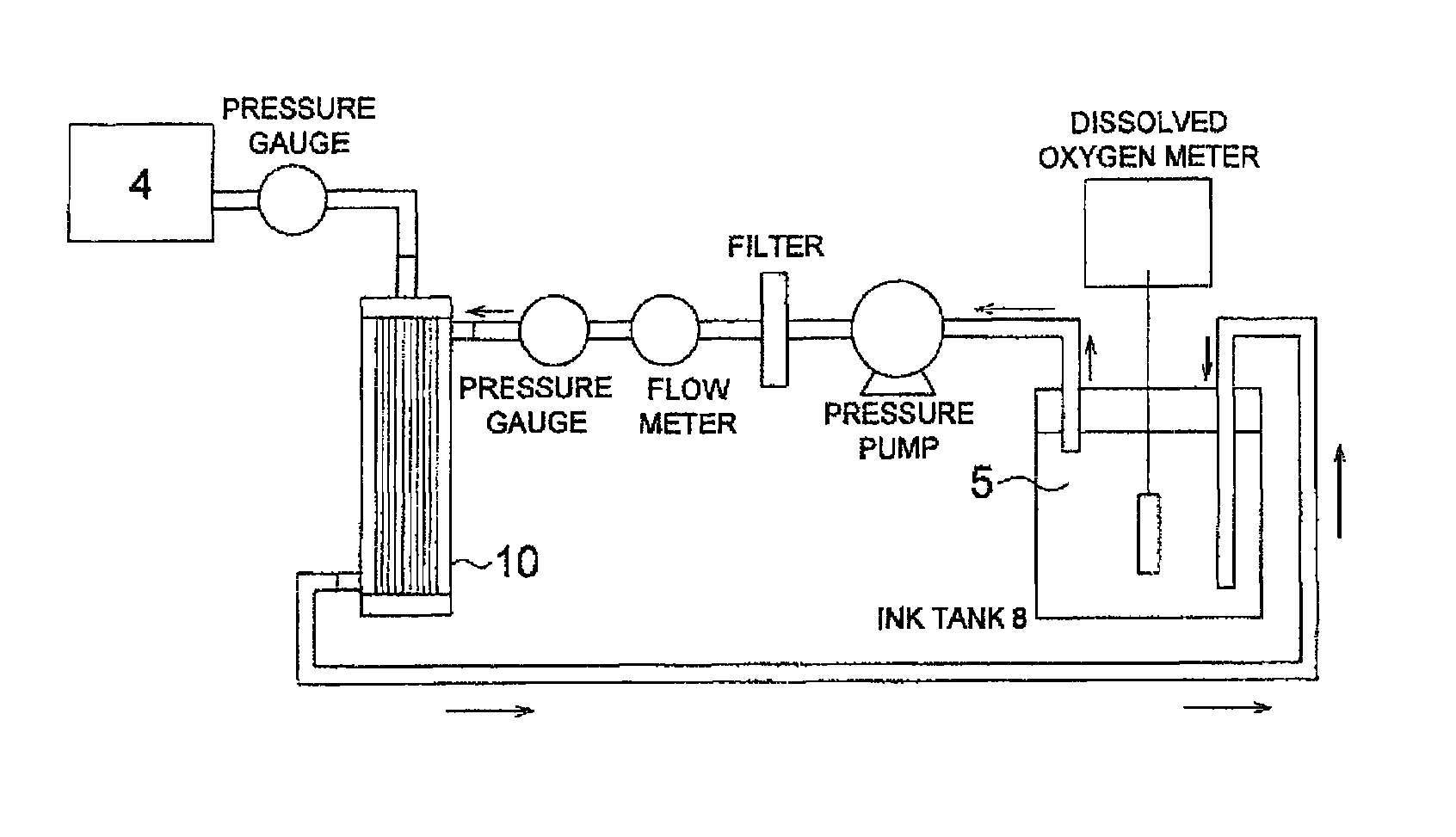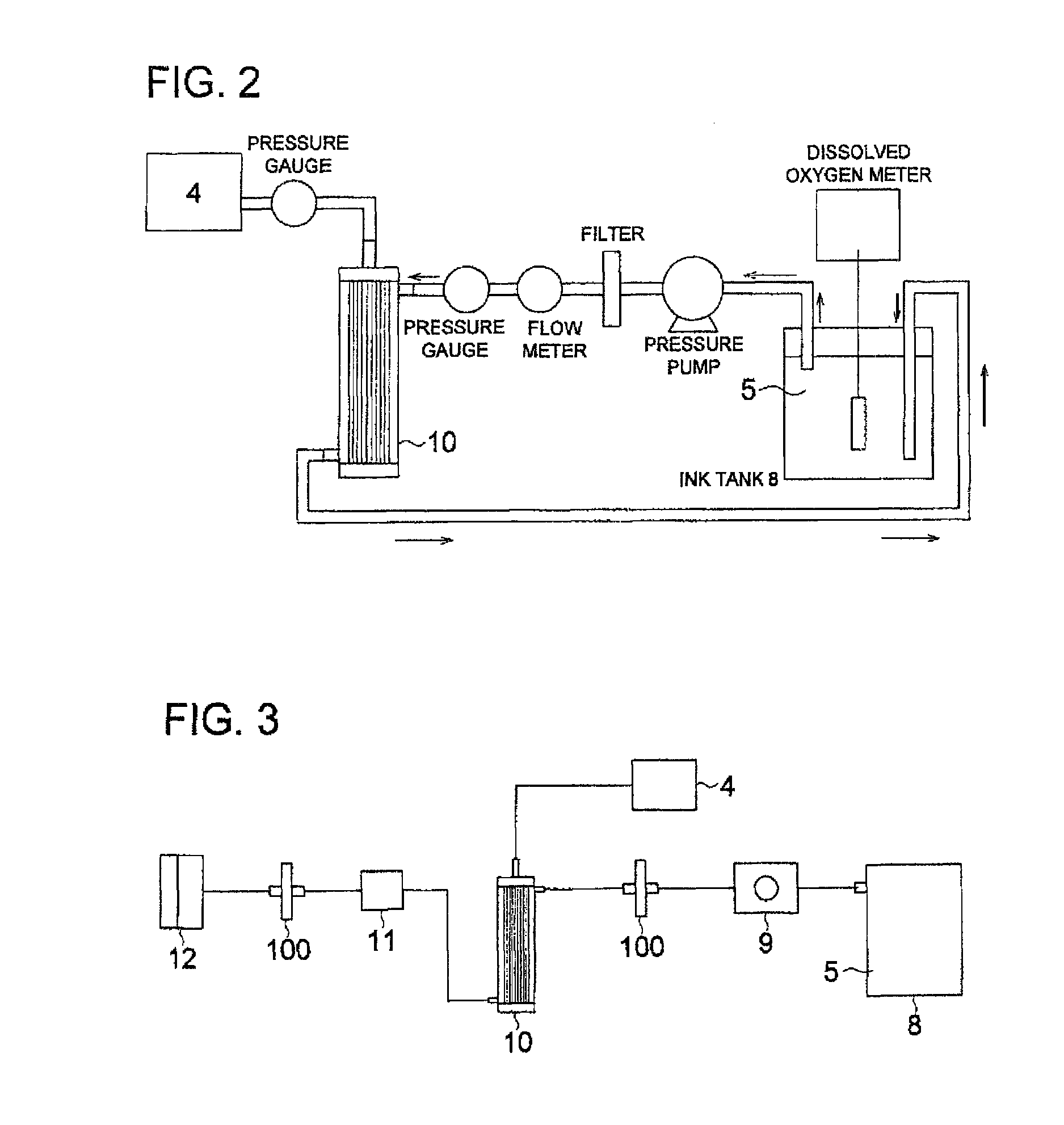Degassing method of ink-jet ink, production method of ink-jet ink and ink-jet printer
a production method and inkjet technology, applied in the field of inkjet printers, can solve the problems of affecting the quality of printed images, and consuming a lot of energy, and achieve excellent ink production, high viscosity pigment ink, and storage stability
- Summary
- Abstract
- Description
- Claims
- Application Information
AI Technical Summary
Benefits of technology
Problems solved by technology
Method used
Image
Examples
example 1
[Preparation of Ink 1]
[0143]According to the formula of dispersion below, a pigment, a water-based solvent, and a high molecular weight dispersing agent were weighed and blended, and the total mass of the mixture was adjusted to 100 parts with deionized water. The resultant solution was initially mixed with a dissolver, and the mixed solution was subjected to dispersion via a bead mill (for example, MiniCer, produced by Ashizawa Finetech Ltd.) filled with 340 g of zirconia beads to prepare a Pigment Dispersion 1.
[0144]
C.I. Pigment Blue 15:315partsJONCRYL 61J (produced by Johnson Polymer Co.)6parts(solid contents)glycerin20parts
[0145]Subsequently, based on the formula of an ink below, each component was weighed and blended, followed by filtration of the mixture employing a #1000 mesh metal filter to prepare an Ink 1.
[0146]
Pigment Dispersion 120partsethylene glycol20partsglycerin15partstriethyleneglycolmonobutylether5partsOLFINE E1010 (produced by Nissin Chemical0.6partIndustry Co., L...
example 2
[Degassing and Evaluation of Continuous Ejection]
[0176]Apparatuses were arranged as illustrated in the aforesaid FIG. 3, and each Ink 1-4 was subjected to ejection from a head for one continuous hour, while being degassed employing the following hollow fiber degassing modules (A) and (B). Ink ejection properties were evaluated using the 5 evaluation levels described below. The evaluation of ink ejection was carried out by observing via a stroboscope ink droplets ejected from the nozzles. The ink flow rate was set to 24 ml / minute corresponding to the ejection. A small tube pump, WPX-1 (produced by WELCO Co., Ltd., at discharge pressure of 0.2 MPa) was employed to feed the ink, assuming that a pump is practically incorporated into a printer. Head conditions: a nozzle number of 2,000, an amount of droplet of 10 pl, and an ejection frequency of 20 kHz.
Internal Refluxing Type Hollow Fiber Degassing Module A
[0177]A small hollow fiber degassing module of an internal refluxing type having a...
example 3
[0191]Inks 7-9 were prepared in the following manner.
[Preparation of Pigment Dispersions]
[0192]According to the formula of dispersion below, a pigment, a water-based solvent, and a high molecular weight dispersing agent were weighed and blended, and the total mass of the mixture was adjusted to 100 parts with deionized water. The resultant solution was initially mixed with a dissolver, and the mixed solution was subjected to dispersion via a bead mill (for example, MiniCer, produced by Ashizawa Finetech Ltd.) filled with 340 g of zirconia beads to prepare a Pigment Dispersion 7.
Formula of Pigment Dispersion 7
[0193]
Carbon black (Mitsubishi MA100: produced15partsby Mitsubishi Chemical Co.)Disperbyk 190 (Big Chemie Corp.)6parts(solid contents)Dipropyleneglycolmonomethylether20parts
[Preparation of Ink 7]
[0194]Subsequently, according to the formula of the ink below, each component was weighed and blended, followed by filtration of the mixture employing a #1000 mesh metal filter to prepar...
PUM
 Login to View More
Login to View More Abstract
Description
Claims
Application Information
 Login to View More
Login to View More - R&D
- Intellectual Property
- Life Sciences
- Materials
- Tech Scout
- Unparalleled Data Quality
- Higher Quality Content
- 60% Fewer Hallucinations
Browse by: Latest US Patents, China's latest patents, Technical Efficacy Thesaurus, Application Domain, Technology Topic, Popular Technical Reports.
© 2025 PatSnap. All rights reserved.Legal|Privacy policy|Modern Slavery Act Transparency Statement|Sitemap|About US| Contact US: help@patsnap.com



